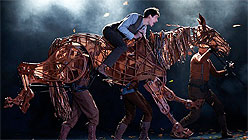War Horse, now through September 9, 2012, at the SHN Curran Theatre in San Francisco, is a sentimental story about a boy named Albert (Andrew Veenstra) and his horse, Joey. Set in prewar Devon, England, and the battlefields of France during World War I, it’s a classic tale of boy meets horse, boy loses horse, boy finds horse again. The end.
That’s pretty much all the theatrical version of Michael Morpurgo’s 1982 young-adult novel would have had going for it if the 2007 National Theatre of Great Britain production (now at Lincoln Center Theater in New York), had relied entirely on this razor-thin plot. Fortunately War Horse has more going on than that. For example, it’s also an engaging musical experience, complete with a singing minstrel (John Milosich) and an accordionist (Nathan Koci), who bring warmth and a sense of authenticity to the teen-equine melodramatics. But most of all, War Horse is a visual spectacle, whose biggest stars are a stable of mechanical horses — and the occasional goose — created by Handspring Puppet Company of South Africa and manipulated by more than a dozen talented puppeteers.

Joey and Topthorn size each other up. Photo: Binkerhoff/Mogenburg.
In fact, this aspect of War Horse has accounted for most of its critical attention, which may be why the novel’s adaptor, Nick Stafford, was content to saddle his actors with uncomplicated tropes, lest their actions on stage pull focus from the production’s main attractions. Still, a few of the performances are good enough to compete with the play’s impressive display of puppetized hardware. Some of my favorite players include Brian Keene, who makes us boo and hiss at his portrayal of Albert’s bullying uncle Arthur in act one, and then cheer for the aptly named Sergeant Thunder, who provides both comic relief and backbone in the play’s somewhat choppy act two. Also excellent are Lavita Shaurice as a young French girl named Emilie and Andrew May’s Captain Friedrich Muller, a German deserter who forms an improbable friendship with the little girl as they work together to save Joey and another horse named Topthorn from certain death on the front line.

Grayson DeJesus as Captain Charles Stewart (left) and Michael Wyatt Cox as Billy (right) prepare to ride Topthorn and Joey into battle. Photo: Binkerhoff/Mogenburg.
I also like the play’s set design by Rae Smith, whose minimalist aesthetic works well with the exposed armature and undisguised manipulation of the puppet horses (the puppeteers blend in, but they never bother to hide). For example, to create a corral for Joey, actors simply hold pieces of partial fencing for as long as the scene requires before dancing off into the shadows and out of sight. Similarly, two pieces of rising and falling railings are all that are needed to create the bow of the ship bringing Joey and the young conscripts from Devon to Calais and their doom. Not coincidentally, the simplicity of the set and the transparent way in which the puppeteers interact with their mechanical steeds makes the schmaltzy dialogue seem all the more clumsy.


